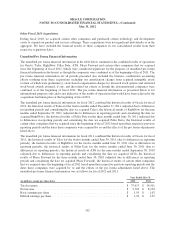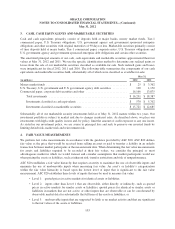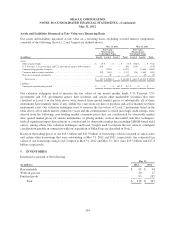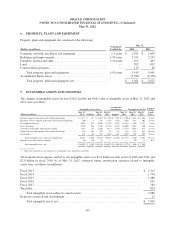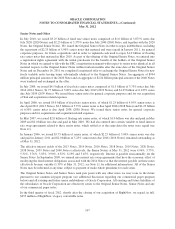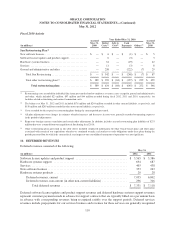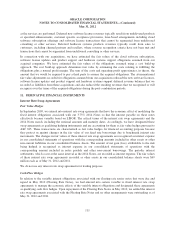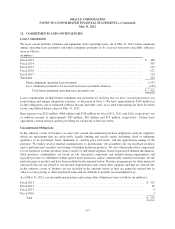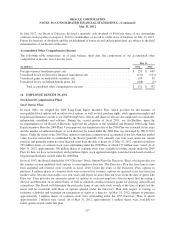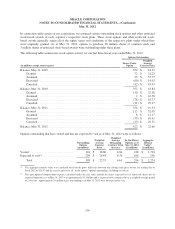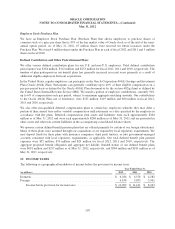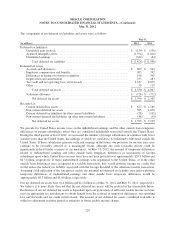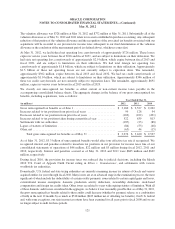Oracle 2012 Annual Report Download - page 115
Download and view the complete annual report
Please find page 115 of the 2012 Oracle annual report below. You can navigate through the pages in the report by either clicking on the pages listed below, or by using the keyword search tool below to find specific information within the annual report.ORACLE CORPORATION
NOTES TO CONSOLIDATED FINANCIAL STATEMENTS—(Continued)
May 31, 2012
as the services are performed. Deferred new software license revenues typically result from undelivered products
or specified enhancements, customer specific acceptance provisions, time-based arrangements including cloud
software subscription offerings and software license transactions that cannot be segmented from undelivered
consulting or other services. Deferred hardware systems products revenues typically result from sales to
customers, including channel partners and resellers, where revenue recognition criteria have not been met and
transactions that cannot be segmented from undelivered consulting or other services.
In connection with our acquisitions, we have estimated the fair values of the cloud software subscription,
software license updates and product support and hardware systems support obligations assumed from our
acquired companies. We have estimated the fair values of the obligations assumed using a cost build-up
approach. The cost build-up approach determines fair value by estimating the costs relating to fulfilling the
obligations plus a normal profit margin. The sum of the costs and operating profit approximates, in theory, the
amount that we would be required to pay a third party to assume the acquired obligations. The aforementioned
fair value adjustments recorded for obligations assumed from our acquisitions reduced the new software licenses,
software license updates and product support and hardware systems support deferred revenue balances that we
recorded as liabilities from these acquisitions and also reduced the resulting revenues that we recognized or will
recognize over the terms of the acquired obligations during the post-combination periods.
11. DERIVATIVE FINANCIAL INSTRUMENTS
Interest Rate Swap Agreements
Fair Value Hedges
In September 2009, we entered into interest rate swap agreements that have the economic effect of modifying the
fixed interest obligations associated with our 3.75% 2014 Notes so that the interest payable on these notes
effectively became variable based on LIBOR. The critical terms of the interest rate swap agreements and the
2014 Notes match, including the notional amounts and maturity dates. Accordingly, we have designated these
swap agreements as qualifying hedging instruments and are accounting for them as fair value hedges pursuant to
ASC 815. These transactions are characterized as fair value hedges for financial accounting purposes because
they protect us against changes in the fair value of our fixed rate borrowings due to benchmark interest rate
movements. The changes in fair values of these interest rate swap agreements are recognized as interest expense
in our consolidated statements of operations with the corresponding amounts included in other assets or other
non-current liabilities in our consolidated balance sheets. The amount of net gain (loss) attributable to the risk
being hedged is recognized as interest expense in our consolidated statements of operations with the
corresponding amount included in notes payable and other non-current borrowings. The periodic interest
settlements, which occur at the same interval as the 2014 Notes, are recorded as interest expense. The fair values
of these interest rate swap agreements recorded as other assets in our consolidated balance sheets were $69
million each as of May 31, 2012 and 2011.
We do not use any interest rate swap agreements for trading purposes.
Cash Flow Hedges
In relation to the variable interest obligations associated with our floating rate senior notes that were due and
repaid in May 2010 (Floating Rate Notes), we had entered into certain variable to fixed interest rate swap
agreements to manage the economic effects of the variable interest obligations and designated these agreements
as qualifying cash flow hedges. Upon repayment of the Floating Rate Notes in May 2010, we settled the interest
rate swap agreements associated with the Floating Rate Notes and no other arrangements were outstanding as of
May 31, 2012 and 2011.
111



